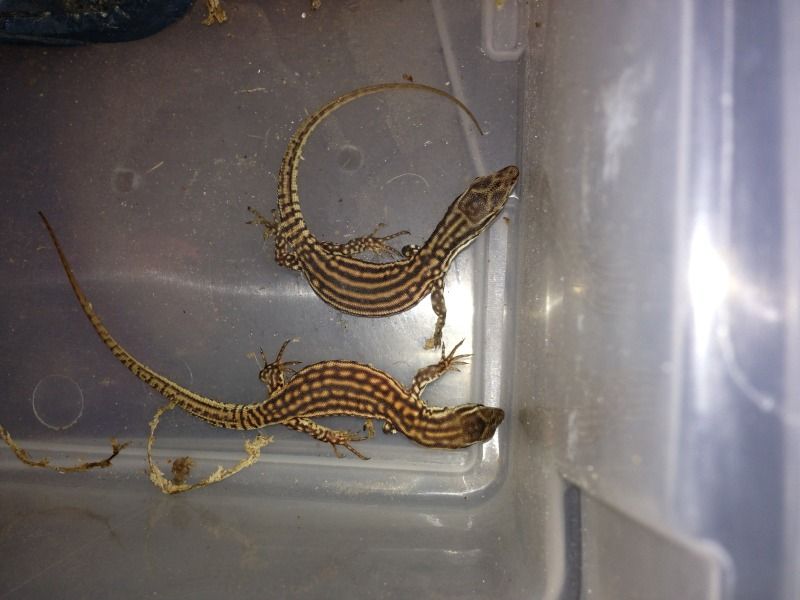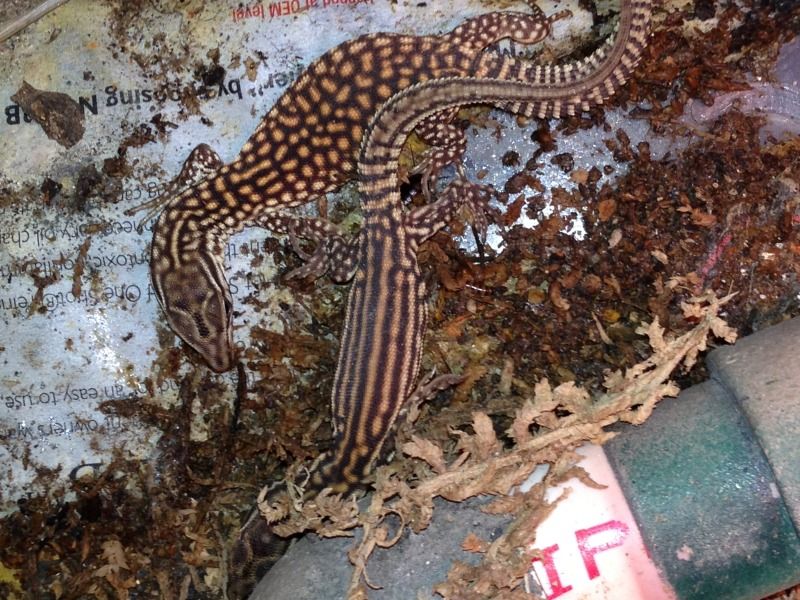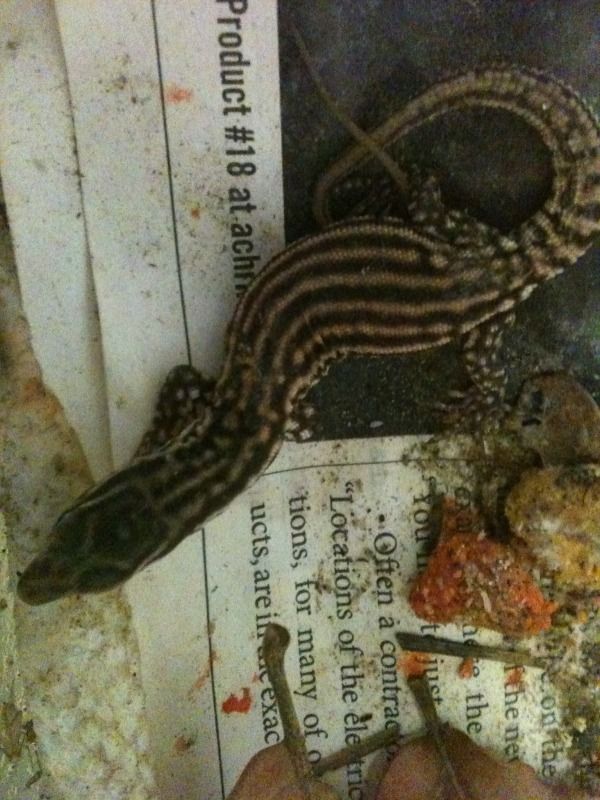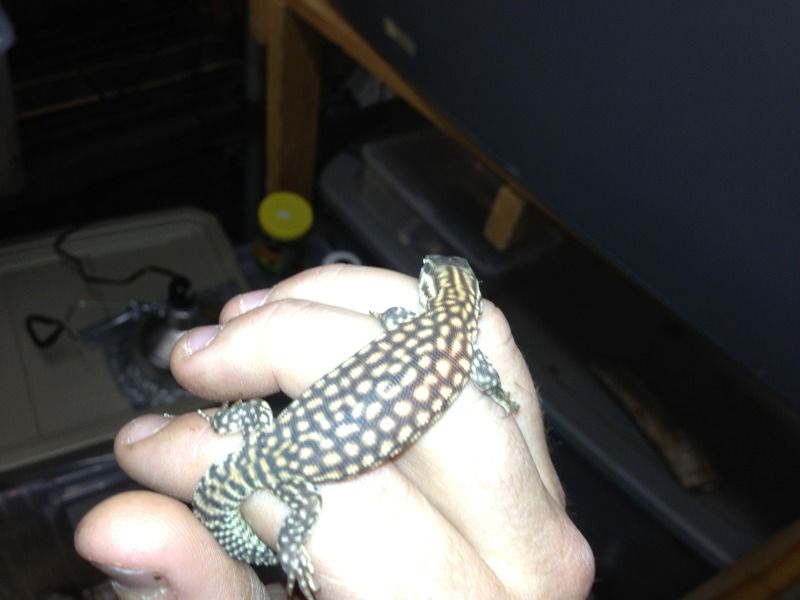|
|  |
| Notices |
Welcome to the sSnakeSs community. You are currently viewing our boards as a guest which gives you limited access to view most discussions and access our other features. By joining our free community you will have access to post topics, communicate privately with other members (PM), respond to polls, upload content and access many other special features. Registration is fast, simple and absolutely free so please, join our community today! If you have any problems with the registration process or your account login, please contact contact us.
|
 01-06-13, 09:32 PM
01-06-13, 09:32 PM
|
#1
|
|
Member
Join Date: Feb-2012
Posts: 378
Country: 
|
possiable ackie morphs
Here is my little secrets that I have been keeping for two weeks. These could prove out to be genetic. Pics are worth a thousand words so Ill let the pics talk.




even though this one isnt stripped I still gave him some photo time. He has a blotchy spots and sticks out from the other 6 "regulars".

there is a total of 9 ackies from this clutch. There was 10 but one passed on after an hour from hatching. It was a partial strip.
Dustin B.
|

|
|
 01-06-13, 09:34 PM
01-06-13, 09:34 PM
|
#2
|
|
Member
Join Date: Nov-2012
Location: Tucson
Posts: 991
Country: 
|
Re: possiable ackie morphs
its like an ackie motley
|

|
|
 01-06-13, 09:38 PM
01-06-13, 09:38 PM
|
#3
|
|
Member
Join Date: Apr-2012
Posts: 2,054
Country: 
|
Re: possiable ackie morphs
Holy cow! That is insane! Are you selling them or keeping them? I'm guessing the latter?
|

|
|
 01-06-13, 10:05 PM
01-06-13, 10:05 PM
|
#4
|
|
Member
Join Date: Feb-2012
Posts: 378
Country: 
|
Re: possiable ackie morphs
keeping and test for genetics on the two stripped and on the "normals". If it turns out to be genetic then I need to figure out if it is recessive, dominant, etc and more importantly if there is a super form 
|

|
|
 01-06-13, 10:31 PM
01-06-13, 10:31 PM
|
#5
|
|
Member
Join Date: Apr-2012
Posts: 2,054
Country: 
|
Re: possiable ackie morphs
If the parents are unrelated (I believe they are?) then unfortunately it's very unlikely it's genetic. If it was just one it could be, but it's extremely unlikely that the same mutation would happen in two individuals. That leaves one or both of the parents having the gene, which if they are unrelated and normal looking, is ruled out.
I'm guessing it has something to do with incubation. In Burmese Pythons, fluctuating incubation temperatures are thought to be the cause of striped Burms that pop up every now and then. Those individuals are also undersized, I have yet to see a striped burm over seven or eight feet.
|

|
|
 01-07-13, 07:02 PM
01-07-13, 07:02 PM
|
#6
|
|
Squamata Concepts
Join Date: Jan-2003
Location: USA
Age: 49
Posts: 2,055
|
Re: possiable ackie morphs
It was told to me by a few individuals when I produced my tiger hognose snakes that it was just a fluke and it could not be genetic because of the amount that hatched. Neither parent had any tiger markings. My first clutch from them produced all tigers. Turns out that my tigers are indeed genetic because I have produced them 3 years in a row. 2 of those years from my male tiger that I produced in that first clutch to unrelated females, even though I was told it was incubation temp fluctuations that caused it and it could not be reproduced. LOL. This year we will be breeding tiger to tiger to figure out how the genetics are working.
Very rarely does a simple incubation temperature fluctuation cause an extreme pattern abberancy. In fact it is not proven that it will cause any abberancy at all.
Also, we need to keep in mind that animals do not have to show a mutation to carry the genes. There could be a multitude of genes working together to cause this mutation. It does not even have to be the same gene or genetic mutation to produce a new morph.
My guess would be polygenic before incubation induced.
Anyway, my point is, nothing can be ruled out until more test breeding is done. This could very well be a genetic pattern morph that can be passed on to other generations. If it is passed down, the mode of inheritance needs to be figured out.
I hope it is genetic because I want me some striped red ackies!!! LOL
Dustin,
Congrats on those awesome ackies bro. Put me on the waiting list!!!!
Quote:
Originally Posted by BarelyBreathing

I really hope their pattern doesn't break up as leopard gecko stripes do.
|
That is not likely to happen BB. Leopard gecko patterns break up naturally. This is something that does not happen in varanids. If anything patterns on varanids expand and become enhanced as the animal grows.
__________________
"A sure fire way for a government to lose control of something is for them to prohibit it."
Last edited by Gregg M; 01-07-13 at 07:09 PM..
|

|
|
 01-08-13, 09:34 AM
01-08-13, 09:34 AM
|
#7
|
|
Varanus Queen
Join Date: Jan-2012
Location: Denver, CO
Posts: 5,078
Country: 
|
Re: possiable ackie morphs
Quote:
Originally Posted by Gregg M

It was told to me by a few individuals when I produced my tiger hognose snakes that it was just a fluke and it could not be genetic because of the amount that hatched. Neither parent had any tiger markings. My first clutch from them produced all tigers. Turns out that my tigers are indeed genetic because I have produced them 3 years in a row. 2 of those years from my male tiger that I produced in that first clutch to unrelated females, even though I was told it was incubation temp fluctuations that caused it and it could not be reproduced. LOL. This year we will be breeding tiger to tiger to figure out how the genetics are working.
Very rarely does a simple incubation temperature fluctuation cause an extreme pattern abberancy. In fact it is not proven that it will cause any abberancy at all.
Also, we need to keep in mind that animals do not have to show a mutation to carry the genes. There could be a multitude of genes working together to cause this mutation. It does not even have to be the same gene or genetic mutation to produce a new morph.
My guess would be polygenic before incubation induced.
Anyway, my point is, nothing can be ruled out until more test breeding is done. This could very well be a genetic pattern morph that can be passed on to other generations. If it is passed down, the mode of inheritance needs to be figured out.
I hope it is genetic because I want me some striped red ackies!!! LOL
Dustin,
Congrats on those awesome ackies bro. Put me on the waiting list!!!!
That is not likely to happen BB. Leopard gecko patterns break up naturally. This is something that does not happen in varanids. If anything patterns on varanids expand and become enhanced as the animal grows.
|
I so hope you're right!
__________________
Quote:
|
Originally Posted by A Whimsical Observer
A seed is a tiny plant, in a box, with its lunch.
|
|

|
|
 01-08-13, 05:27 PM
01-08-13, 05:27 PM
|
#8
|
|
Tempgun.com
Join Date: Mar-2012
Location: Denver CO
Posts: 142
Country: 
|
Re: possiable ackie morphs
A genetically striped Ackie would be a boon to the monitor world! Best of luck!
|

|
|
 01-09-13, 03:26 AM
01-09-13, 03:26 AM
|
#9
|
|
Member
Join Date: Apr-2012
Posts: 9
Country: 
|
Re: possiable ackie morphs
Quote:
Originally Posted by Pirarucu

If the parents are unrelated (I believe they are?) then unfortunately it's very unlikely it's genetic. If it was just one it could be, but it's extremely unlikely that the same mutation would happen in two individuals. That leaves one or both of the parents having the gene, which if they are unrelated and normal looking, is ruled out.
I'm guessing it has something to do with incubation. In Burmese Pythons, fluctuating incubation temperatures are thought to be the cause of striped Burms that pop up every now and then. Those individuals are also undersized, I have yet to see a striped burm over seven or eight feet.
|
Sorry man but this is not correct. If the mutation were a random novel mutation, IE both parents are normal but produced one sperm or egg cell that had a point mutation, then you would expect a single unique animal in a clutch of normals. If the parents are both het for a rare mutation, then you would expect a mix of the mutation and the normals. If both the parents are normal looking than I would not think that this will be codom/super, recessive is possible though.
The small size of the originating ackie gene pool could be viewed in 2 ways. On the one hand, small gene pools concentrate rare alleles, increasing the likelihood that rare hets will breed. On the other hand, this small gene pool has been fairly well intermixed and nothing unusual has popped out... yet. Erratic temps have certainly caused striping but I am only aware of this being documented in snakes. The fact that this is the first clutch from a new male is also interesting.
The bottom line is that we wont know anything until he proves em out! Regardless they are beautiful and even if not a morph they would be awesome to do some line breeding to refine the look. Good luck man!
|

|
|
 01-09-13, 07:08 AM
01-09-13, 07:08 AM
|
#10
|
|
Member
Join Date: Apr-2012
Posts: 2,054
Country: 
|
Re: possiable ackie morphs
Quote:
Originally Posted by zwhitman

Sorry man but this is not correct. If the mutation were a random novel mutation, IE both parents are normal but produced one sperm or egg cell that had a point mutation, then you would expect a single unique animal in a clutch of normals. If the parents are both het for a rare mutation, then you would expect a mix of the mutation and the normals. If both the parents are normal looking than I would not think that this will be codom/super, recessive is possible though.
The small size of the originating ackie gene pool could be viewed in 2 ways. On the one hand, small gene pools concentrate rare alleles, increasing the likelihood that rare hets will breed. On the other hand, this small gene pool has been fairly well intermixed and nothing unusual has popped out... yet. Erratic temps have certainly caused striping but I am only aware of this being documented in snakes. The fact that this is the first clutch from a new male is also interesting.
The bottom line is that we wont know anything until he proves em out! Regardless they are beautiful and even if not a morph they would be awesome to do some line breeding to refine the look. Good luck man!
|
However the same concept applies to the parents that applies to the babies. It's unlikely that two animals presumably not siblings would both be het for a recessive gene that hasn't been seen before. If striped Ackies had turned up before then it would be more plausible, but they haven't so far as we know.
I am well aware the temps causing striping has only been documented in snakes, that was merely a suggestion, not a definite conclusion. Monitors have not been bred as much as snakes, we don't know what unusual conditions may or may not cause in Varanids.
Then of course we must remember that the field of genetics is still largely speculation and guesswork, and unexplained things still happen. Perhaps these Ackies are the result of a type of gene yet unknown to science.
I agree, the bottom line is we can do nothing but guess for the moment. Raise them up and prove them out!
|

|
|
 01-09-13, 08:56 AM
01-09-13, 08:56 AM
|
#11
|
|
Member
Join Date: Oct-2012
Age: 33
Posts: 1,431
Country: 
|
Re: possiable ackie morphs
Quote:
Originally Posted by Pirarucu

However the same concept applies to the parents that applies to the babies. It's unlikely that two animals presumably not siblings would both be het for a recessive gene that hasn't been seen before. If striped Ackies had turned up before then it would be more plausible, but they haven't so far as we know.
I am well aware the temps causing striping has only been documented in snakes, that was merely a suggestion, not a definite conclusion. Monitors have not been bred as much as snakes, we don't know what unusual conditions may or may not cause in Varanids.
Then of course we must remember that the field of genetics is still largely speculation and guesswork, and unexplained things still happen. Perhaps these Ackies are the result of a type of gene yet unknown to science.
I agree, the bottom line is we can do nothing but guess for the moment. Raise them up and prove them out!
|
The first post says:
Quote:
|
there is a total of 9 ackies from this clutch. There was 10 but one passed on after an hour from hatching. It was a partial strip.
|
I don't think they're unrelated.
~Maggot
__________________
Announcing "I'm offended" is basically telling the world you can't control your own emotions, so everyone else should do it for you.
|

|
|
 01-09-13, 04:02 PM
01-09-13, 04:02 PM
|
#12
|
|
Member
Join Date: Apr-2012
Posts: 2,054
Country: 
|
Re: possiable ackie morphs
Quote:
Originally Posted by EmbraceCalamity

The first post says:I don't think they're unrelated.
~Maggot
|
I am talking about the parents, not the striped babies.
|

|
|
 01-06-13, 10:32 PM
01-06-13, 10:32 PM
|
#13
|
|
Member
Join Date: Apr-2012
Posts: 2,054
Country: 
|
Re: possiable ackie morphs
If the parents are unrelated (I believe they are?) then unfortunately it's very unlikely it's genetic. If it was just one it could be, but it's extremely unlikely that the same mutation would happen in two individuals. That leaves one or both of the parents having the gene, which if they are unrelated and normal looking, is ruled out.
I'm guessing it has something to do with incubation. In Burmese Pythons, fluctuating incubation temperatures are thought to be the cause of striped Burms that pop up every now and then. Those individuals are also undersized, I have yet to see a striped burm over seven or eight feet.
|

|
|
 01-06-13, 10:52 PM
01-06-13, 10:52 PM
|
#14
|
|
Varanus Queen
Join Date: Jan-2012
Location: Denver, CO
Posts: 5,078
Country: 
|
Re: possiable ackie morphs
Well that's interesting. AWESOME! Congratulations.
__________________
Quote:
|
Originally Posted by A Whimsical Observer
A seed is a tiny plant, in a box, with its lunch.
|
|

|
|
 01-07-13, 06:14 AM
01-07-13, 06:14 AM
|
#15
|
|
Member
Join Date: Feb-2012
Posts: 378
Country: 
|
Re: possiable ackie morphs
That incubation method is crap at least as far as these guys are concerned. Varying temps have caused crooked spines, hatch with egg sacs or large die offs after hatching. I have had ackies range from 100s down to low 80s and never had stripping before. These held constant at 86.5 controlled by herpstat (digital) and heat supplied by heat tape. Now they did become turgid the last month and that could be it. However the father is odd himself and really the only wild card in this. He is new where everything else has become more
constant. I will test it out and see. If it doesn't turn out to be like a normal morph in terms of recessive, dominant, etc then I might be able to line breed it like some do for colors.
One last fun piece of info. For the most part, all ackies in the USA are related. Most ackies derived from a few individuals since Australia isn't large into exporting/importing. Bloodlines from Europe and Canada would be exceptions to this rule since I'm not sure about their origins. Anyone know how many ackies fr brought over?
|

|
|
 Posting Rules
Posting Rules
|
You may not post new threads
You may not post replies
You may not post attachments
You may not edit your posts
HTML code is Off
|
|
|
All times are GMT -6. The time now is 05:14 AM.
Powered by vBulletin®
©2000 - 2025, Jelsoft Enterprises Ltd.

Copyright © 2002-2023, Hobby Solutions.
|
 |



